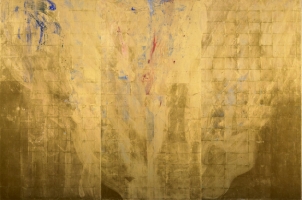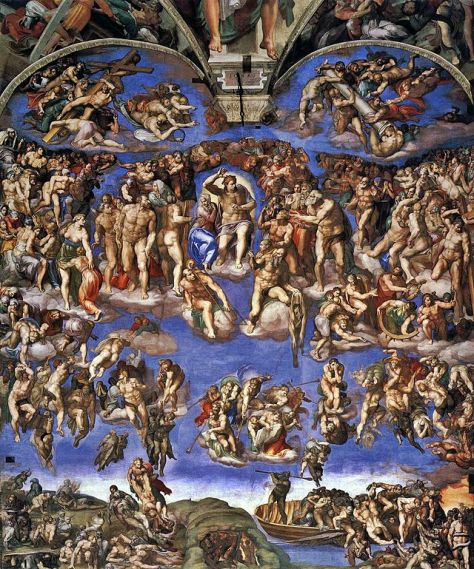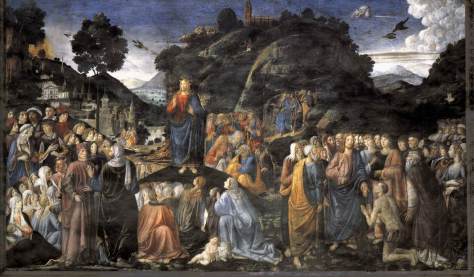
Creation of Eve, Michelangelo Buonarroti, 1509-10, fresco, Sistine Chapel, Rome
The LORD God said: “It is not good for the man to be alone.
I will make a suitable partner for him.”
So the LORD God formed out of the ground
various wild animals and various birds of the air,
and he brought them to the man to see what he would call them;
whatever the man called each of them would be its name.
The man gave names to all the cattle,
all the birds of the air, and all wild animals;
but none proved to be the suitable partner for the man.
So the LORD God cast a deep sleep on the man,
and while he was asleep,
he took out one of his ribs and closed up its place with flesh.
The LORD God then built up into a woman the rib
that he had taken from the man.
When he brought her to the man, the man said:
“This one, at last, is bone of my bones
and flesh of my flesh;
this one shall be called ‘woman, ‘
for out of ‘her man’ this one has been taken.”
That is why a man leaves his father and mother
and clings to his wife,
and the two of them become one flesh.
Genesis 2:18-24
Today’s reading describes the creation of Eve and remains the basis for the Christian theology of marriage. No matter where one stands on the literal truth or application of the Genesis tale, it has certainly been a fertile subject for artists. The most well known image of the creation of Eve is undoubtedly that by Michelangelo in the Sistine Chapel, shown above.
From Art Encyclopedia: “The iconography follows the tradition of showing God standing on the Earth alongside his creatures, but the artist nicely exploits the format of the small field by showing God’s head bumping up against the frame. The Sistine Chapel was dedicated to the Virgin Mary. Since Mary is regarded as the second Eve, who erased the original sin of that first woman, it is logical that the scene representing the Creation of Eve should be placed in the exact center of the ceiling.”

Birth of Eve, Wiligelmo, 1110, Cathedral of Modena, Italy
The relief sculpture above is from the west facade of the cathedral at Modena. It was sculpted by the Italian Wiligelmo, who brought life-sized sculptures to Italy in the Romanesque Period. The scenes are sculpted in high relief, with Roman arches and columns behind. We can see the stylistic quirks of the period, such as the unnatural body proportions and lack of naturalism. At left, we see Christ in a mandorla supported by two angels. To our right the next scene is the creation of Adam, followed by Eve’s creation from his side as he sleeps. Finally we see the pair with the tree of the temptation.

Creation of Adam and Eve from Gate of Paradise, Lorenzo Ghiberti, 1425-52, gilded bronze Baptistry, Florence.
From the 2007 exhibit of three of the panels from the Gates of Paradise at the Art Institute of Chicago:
“Created in the mid-15th century and installed in the eastern portal of the Baptistery, the Gates of Paradise have been praised by generations of artists and art historians for their compelling portrayal of scenes from the Old Testament. Over time, the seventeen-foot-tall, three-ton bronze doors became an icon of Renaissance art and a touchstone of civic and religious life in Florence. This exhibition showcases three panels from the left door of the Gates of Paradise, which depict the stories of Adam and Eve, Jacob and Esau, and David and Goliath. The exhibition also includes figures and heads of prophets from the doorframe, and it explores the evolving nature of art in Florence and Siena during Ghiberti’s career with works from the Art Institute’s permanent collection.
The Adam and Eve Panel documents Ghiberti’s earliest work on the doors and features a splendid depiction of nude figures in a landscape set off by angelic hosts. Ghiberti combined four major episodes from the story of Adam and Eve into this harmonious panel. The creation of Adam, illustrated in the foreground on the far left, shows Adam in a state of semiconsciousness, rising in response to God’s life-giving touch. In the center, as angels look on, God forms Eve from one of Adam’s ribs. The temptation of Adam and Eve by the serpent is shown in the background on the left, while the right side of the panel depicts the couple’s expulsion from Eden. Subtle shifts in the scale of the figures reinforce discrete episodes in the story of the Creation. Ghiberti modulated the scale and degree of projection of the angels to visually separate the four scenes.”

Creation of Eve, Giusto de’ Menabuoi, 1376-78, fresco Chapel of S. Giovanni Battista, Padua
Menabuoi was a 14th century Florentine painter mentioned by Vasari in his Lives of the Artists. His frescoes in the Chapel of S. Giovanni in northern Italy’s Padua were executed between 1376 and 1378.

Creation of Eve, Henry Fuseli, 1793, Oil on canvas, Hamburger Kunsthalle, Hamburg
Created for his gallery of images illustrating Milton’s Paradise Lost, Fuseli’s Creation of Eve shows her rising from Adam in the conventional manner, but with an ambiguous image of a man in the upper right. Is it God? This work apparently created some theological controversy. Much of Fuseli’s work is known for its surreal, supernatural content.

Angel of the Divine Presence Bringing Eve to Adam (The Creation of Eve: “And She Shall be Called Woman), William Blake, 1803, Watercolor, pen and black ink over graphite, Metropolitan Museum of Art, New York.
From the Met website: Blake considered the Bible to be the supreme poetic work and here evocatively re-imagined the Old Testament theme of the creation of Eve. Instead of showing the first woman emerging from Adam’s side, Blake presents the couple meeting with ceremonial solemnity. A divine figure prepares to join their hands while a recumbent Adam looks up eagerly as his mate steps down from blue-tinged clouds. Objects in the landscape elaborate the meaning: the grape vines entwined around the tree symbolize marriage; the exotic red and blue plumed birds represent the newly created souls; and the giant oak leaf on which Adam reclines forecasts humankind’s suffering. A lion dozing near grazing lambs at lower right signals the peace of the pre-fallen world. Blake made this finished watercolor for his loyal patron Thomas Butts.

Genesis Windows, Marc Chagall, 1963, St Etienne Cathedral, Metz, France
Readers of this blog know that Marc Chagall is one of my most beloved artists, so it’s fitting that this page conclude with Chagall’s image of Eve. He depicted the creation of Eve in one of his many stained glass projects, this time from the cathedral at Metz. In the third window, Eve is the figure with rose coloring through torso and legs, rising from the supine figure of Adam. Here’s a detail:

Chagall wrote: “To me, stained glass is the transparent wall between my heart and the world’s. Stained glass is uplifting, it requires gravity and passion. It must come alive through the light it receives. The Bible is light already, and stained glass should make this obvious through grace and simplicity.” (more on the Cathedral and its stained glass here)






























